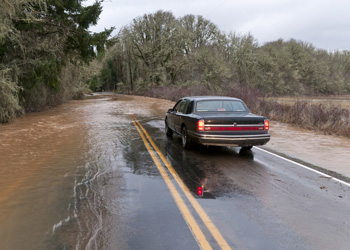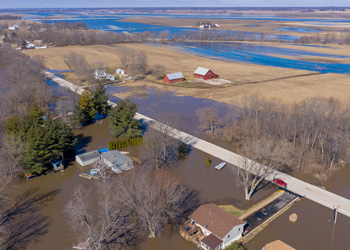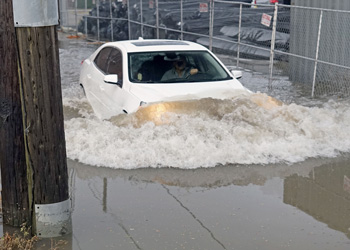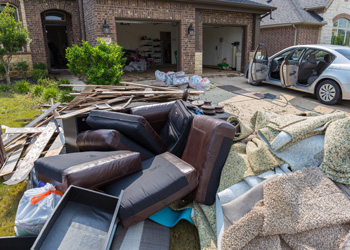Flood Safety
- Get Prepared
- Nature Safety
- Current: Flooding
The most common natural disaster America faces is flooding. In 2024, 181 lives were lost in floods. Natural disasters such as floods are unpredictable due to the fact they can take a few weeks or a few hours to develop. Floods cannot be prevented, but Hoosiers can be prepared when one occurs by taking the following safety precautions and considering buying flood insurance.
Flood Safety Tips
Quick Tips
- Contact insurance providers to purchase flood insurance. New policies take 30 days to become effective, so plan ahead.
- Become aware of flood plains nearby. Create a map of multiple possible evacuation routes in case they flood.
- Do not try to drive through floodwater because as little as 2 feet can cause most cars to float.
- After floods, stay out of any building if floodwaters remain. Avoid entering it before local officials have said it is safe to do so.
- Find a comprehensive set of resources about preparing for floods, flood insurance, recovering from a flood and more at Floodsmart.gov.

Terms to Know
A variety of weather terms are used during natural disasters like flooding, and while they may sound similar, there are important differences among them.
- Flood: The overflowing of a waterway into a normally dry area.
- Flash Flood: A heavy rush of water normally caused by heavy rains. Flash floods occur with little to no warning.
- Flood Watch: Conditions for local flooding are favorable, or conditions may develop that lead to flash flooding.
- Flood Warning: A flood is occurring or is likely to occur soon.
- Flash Flood Warning: Flash flooding is imminent or occurring.

Before a Flood
A flood can occur without much prior warning. Following a few, simple safety tips to prepare before a flood occurs will help keep the entire household safe during a stressful situation.
- Contact insurance providers to purchase flood insurance. New policies take 30 days to become effective, so plan ahead.
- Become aware of any flood plains in the area. Flood plains are flat areas of land near a body of water that is prone to flooding.
- If in a flood plain, install hot water heaters, electrical panels and furnaces on floors that have lower chances of being flooded.
- Make sure preparedness kits are portable for easy transport if evacuation is necessary. Preparedness kits should be tailored to household needs. Create a map of multiple possible evacuation routes.
- Have the basement waterproofed.
- If flooding is possible, try and create a barrier between the property and the water, or its likely path.

During a Flood
- Immediately evacuate the home and go to high ground if flooding is possible.
- If evacuating, take all pets, but choose a pet-friendly evacuation spot beforehand.
- Do not try to drive through water because as little as 2 feet can cause most cars to float, and as little as a few inches of moving water can wash most cars away with the current.
- Do not try to cross moving water on foot since as little as a few inches can knock an adult off his or her feet.
- Stay out of floodwaters. They can contain hazards such as waste and contaminants, downed power lines, vehicles, signs and trees.
- Monitor local news radio, TV or social media postings for additional information or instructions from local officials.

After a Flood
Recovery after a flood focuses on the citizen’s safety. Diligently following safety tips and information provided by local officials will help make the recovery process run as efficiently as possible.
- If injured, seek necessary medical care at the nearest hospital or clinic.
- Avoid disaster areas.
- Report broken utility lines to the appropriate authorities.
- Stay out of any building if floodwaters remain around the establishment.
- Avoid entering any building before local officials have said it is safe to do so.
- When entering buildings, use extreme caution. Watch for loose plaster, drywall and ceilings that could fall. Take pictures of the damage, both of the building and its contents, for insurance claims.
- Look for fire hazards.
- Use battery-powered lanterns or flashlights when examining buildings.
- Wear sturdy shoes.
- Watch out for animals, especially poisonous snakes that may have come into buildings with the floodwaters.
- Throw away food that has come into contact with floodwaters. Some canned foods may be salvageable.
- Do not drink or use floodwater.
- Pump out a flooded basement gradually (about one-third of the water per day) to avoid structural damage.
- Professionally service damaged septic tanks, cesspools, pits and leaching systems as soon as possible.
- Follow FEMA or Red Cross guidelines about cleaning flood-damaged homes.
Resources
Websites
- Disaster Response
FEMA - Flood Safety Tips
U.S. Centers for Disease Control and Prevention - Flood Safety Tips and Resources
National Weather Service - Floods
Ready.gov - Turn Around, Don't Drown
National Weather Service
State Multi-Hazard Mitigation Plan
The State Multi-Hazard Mitigation Plan lays the foundation to building resiliency in the State of Indiana by identifying Indiana's greatest risks for disasters and creating strategies to mitigate these risks. The plan makes Indiana eligible to apply for, and receive, FEMA Hazard Mitigation Assistance funding.
